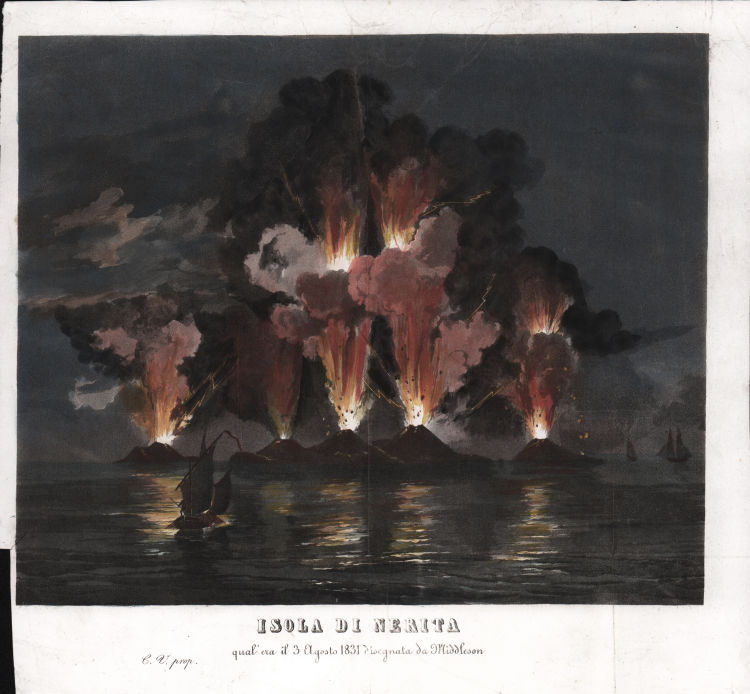




| Reference: | S45124 |
| Author | Anonimo |
| Year: | 1831 |
| Zone: | Graham Island |
| Printed: | Naples |
| Measures: | 270 x 255 mm |



| Reference: | S45124 |
| Author | Anonimo |
| Year: | 1831 |
| Zone: | Graham Island |
| Printed: | Naples |
| Measures: | 270 x 255 mm |
Very rare separately published print depicting the mythical Ferdinandea (Graham) Island, which emerged in July 1831 in the Sicilian Channel and disappeared in December of the same year.
The print - probably by a Neapolitan publisher - depicts the state of the island on August 3, 1831; it shows the erupting volcanic vents, observed - from a distance - by several vessels. The lower left-hand corner reads "C. V. prop." probably the printer of this aquatint engraving "disegnata da Middleson" (drawn by Middleson). We have no record of such a Middleson; it is not ruled out that he was an English draughtsman embarked on board one of the British naval vessels.
The emergence of this island gave rise to a sovereignty dispute between the French and English governments and the Kingdom of the Two Sicilies, which claimed ownership.
'Isola Ferdinandea' is the Italian name for an island or, rather, what remains of a volcanic island that emerged in the Sicilian Channel in 1831, 27 nautical miles off the coast of Sciacca, in the province of Agrigento. "Ferdinandea," but it has had many other names: Giulia, Nerita, Corrao, Hotham, Graham, Sciacca. At present it is no longer an island but a shoal, that is, basically an underwater volcanic cone whose summit is about 9 meters deep, while the base lies on a seabed that varies between 150 and 200 meters deep.
It was given its Italian name by a Bourbon captain, Giovanni Corrao, on the recommendation of University of Catania geologist Carlo Gemmellaro, in honor of King Ferdinando II of Borbone, who ruled the Kingdom of the Two Sicilies at that time. The emergence of this island gave rise to a sovereignty dispute between the French and British governments and the Kingdom of the Two Sicilies, which claimed ownership. Therefore, this island is also known by other names, and among them, one of the most important is 'Julia,' which was given to it by the French as it emerged from the sea in July 1831 (July is juillet, in French), almost 190 years ago. The other most important name related to Ferdinandea Island is 'Graham,' which was given to her by an admiral of the British fleet stationed in Malta (then a British crown colony) in honor of Sir Graham. This name was later reflected on international nautical maps and consequently in scientific journals. Hence, at present, the correct name to be given to what remains of this island is “Banco Graham”, which actually stands for a volcanic edifice formed by the coalescence of two volcanic cones, the Ferdinandea and another larger cone that a few thousand years earlier in turn gave rise to another volcanic islet.
Aquatint, finely hand-colored, short margin on left, otherwise in excellent condition.
A very rare print, of which we have found no records, other than its mention in the Bibliographie Seismique par M. Alexis Perrey (1857).
Bibliografia
M. A. Perrey, Bibliographie Seismique par M. Alexis Perrey, in “Mémoires de lʹAcadémie des sciences, arts et belles-lettres de Dijon” (1857), p. 247, n. 1784.
Anonimo
Anonimo